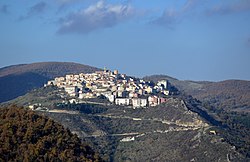Albano di Lucania
- Machine translation, like DeepL or Google Translate, is a useful starting point for translations, but translators must revise errors as necessary and confirm that the translation is accurate, rather than simply copy-pasting machine-translated text into the English Wikipedia.
- Do not translate text that appears unreliable or low-quality. If possible, verify the text with references provided in the foreign-language article.
- You must provide copyright attribution in the edit summary accompanying your translation by providing an interlanguage link to the source of your translation. A model attribution edit summary is
Content in this edit is translated from the existing Italian Wikipedia article at [[:it:Albano di Lucania]]; see its history for attribution. - You may also add the template
{{Translated|it|Albano di Lucania}}to the talk page. - For more guidance, see Wikipedia:Translation.
Albano di Lucania | |
|---|---|
Comune | |
| Comune di Albano di Lucania | |
 | |
Location of Albano di Lucania  | |
40°35′N 16°2′E / 40.583°N 16.033°E / 40.583; 16.033 | |
| Country | Italy |
| Region | Basilicata |
| Province | Potenza (PZ) |
| Government | |
| • Mayor | Bruno Santamaria |
| Area | |
| • Total | 55.87 km2 (21.57 sq mi) |
| Elevation | 899 m (2,949 ft) |
| Population (30 April 2017)[2] | |
| • Total | 1,420 |
| • Density | 25/km2 (66/sq mi) |
| Demonym | Albanesi |
| Time zone | UTC+1 (CET) |
| • Summer (DST) | UTC+2 (CEST) |
| Postal code | 85010 |
| Dialing code | 0971 |
| Patron saint | St. Vitus |
| Saint day | 15 June |
| Website | Official website |
Albano di Lucania (Lucano: Albànë) is a town and comune in the province of Potenza, in the southern Italian region of Basilicata.
History
The village's origins are uncertain due to limited written records. Over the centuries, it was ruled by various noble families: the D'Alba until 1301, followed by the Pipino family. In the fifteenth and sixteenth centuries, Albano was part of the Sanseverino fiefdom, and until 1800, it was under the rule of the dukes Ruggiero.
During World War II, a family of Austrian Jewish refugees (a father, mother, and child) were confined to forced residence in Albano. They were liberated with the arrival of the Allied army in September 1943.
Main sights
The main sight in the town is the Mother Church of Santa Maria Maggiore (previously: chiesa Madonna della neve).
Ethnography
During 1956 and 1957, Albano served as the destination for Ernesto de Martino's ethnographic expedition to Basilicata. Specifically, from July 31 to August 17, 1956, the focus was on studying popular songs and funeral rituals, followed by a broader survey from May 15 to June 10, 1957, including neighboring areas, on healers and their clients. The findings from this research were later summarized in a chapter of the book 'Sud e magia'.[3]
References
- ^ "Superficie di Comuni Province e Regioni italiane al 9 ottobre 2011". Italian National Institute of Statistics. Retrieved 16 March 2019.
- ^ All demographics and other statistics from the Italian statistical institute (Istat)
- ^ Ernesto de Martino [in Italian]. "Magia lucana". Sud e magia (1959 ed.). Feltrinelli. Par.7.
External links
- Pro Loco Tourist Association of Albano di Lucania Archived 2020-02-18 at the Wayback Machine
- v
- t
- e
- Abriola
- Acerenza
- Albano di Lucania
- Anzi
- Armento
- Atella
- Avigliano
- Balvano
- Banzi
- Baragiano
- Barile
- Bella
- Brienza
- Brindisi Montagna
- Calvello
- Calvera
- Campomaggiore
- Cancellara
- Carbone
- Castelgrande
- Castelluccio Inferiore
- Castelluccio Superiore
- Castelmezzano
- Castelsaraceno
- Castronuovo di Sant'Andrea
- Cersosimo
- Chiaromonte
- Corleto Perticara
- Episcopia
- Fardella
- Filiano
- Forenza
- Francavilla in Sinni
- Gallicchio
- Genzano di Lucania
- Ginestra
- Grumento Nova
- Guardia Perticara
- Lagonegro
- Latronico
- Laurenzana
- Lauria
- Lavello
- Maratea
- Marsico Nuovo
- Marsicovetere
- Maschito
- Melfi
- Missanello
- Moliterno
- Montemilone
- Montemurro
- Muro Lucano
- Nemoli
- Noepoli
- Oppido Lucano
- Palazzo San Gervasio
- Paterno
- Pescopagano
- Picerno
- Pietragalla
- Pietrapertosa
- Pignola
- Potenza
- Rapolla
- Rapone
- Rionero in Vulture
- Ripacandida
- Rivello
- Roccanova
- Rotonda
- Ruoti
- Ruvo del Monte
- San Chirico Nuovo
- San Chirico Raparo
- San Costantino Albanese
- San Fele
- San Martino d'Agri
- San Paolo Albanese
- San Severino Lucano
- Sant'Angelo Le Fratte
- Sant'Arcangelo
- Sarconi
- Sasso di Castalda
- Satriano di Lucania
- Savoia di Lucania
- Senise
- Spinoso
- Teana
- Terranova di Pollino
- Tito
- Tolve
- Tramutola
- Trecchina
- Trivigno
- Vaglio Basilicata
- Venosa
- Vietri di Potenza
- Viggianello
- Viggiano
 | This Basilicata location article is a stub. You can help Wikipedia by expanding it. |
- v
- t
- e











